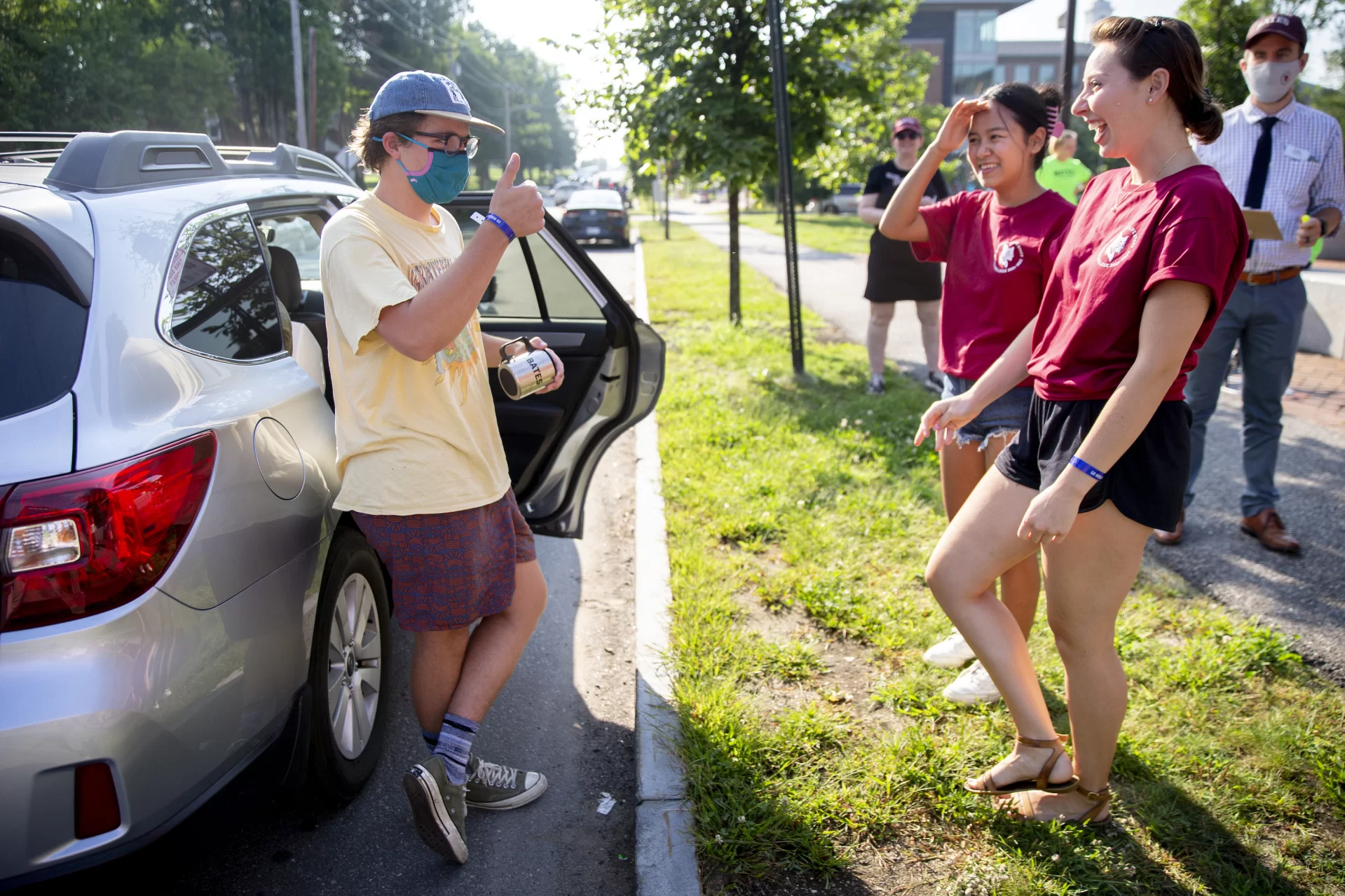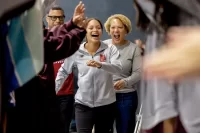
This annual year-end presentation of Bates images is typically referred to as our photographers’ “favorite” images. But like you, we kinda cringe at putting “favorite” and “2020” in the same sentence.
But even during a pandemic, we do play favorites: Bates and Bates people. From that angle, here are some of our favorites: photos from Phyllis Graber Jensen, and behind-the-scenes video clips from multimedia producer Theophil Syslo, from an unfavorable year.
Swabs, swirls, and mortality
Phyllis Graber Jensen: This fall, we limited our photography to mostly outdoor situations, doing our part to ensure physical distancing and the safety of our community.
An exception was this picture — showing Henry Morjikian ’22 of Pelham, N.Y., doing his COVID-19 swab test — which was part of a larger shoot to document COVID-related operations, including the testing center at Underhill Arena.
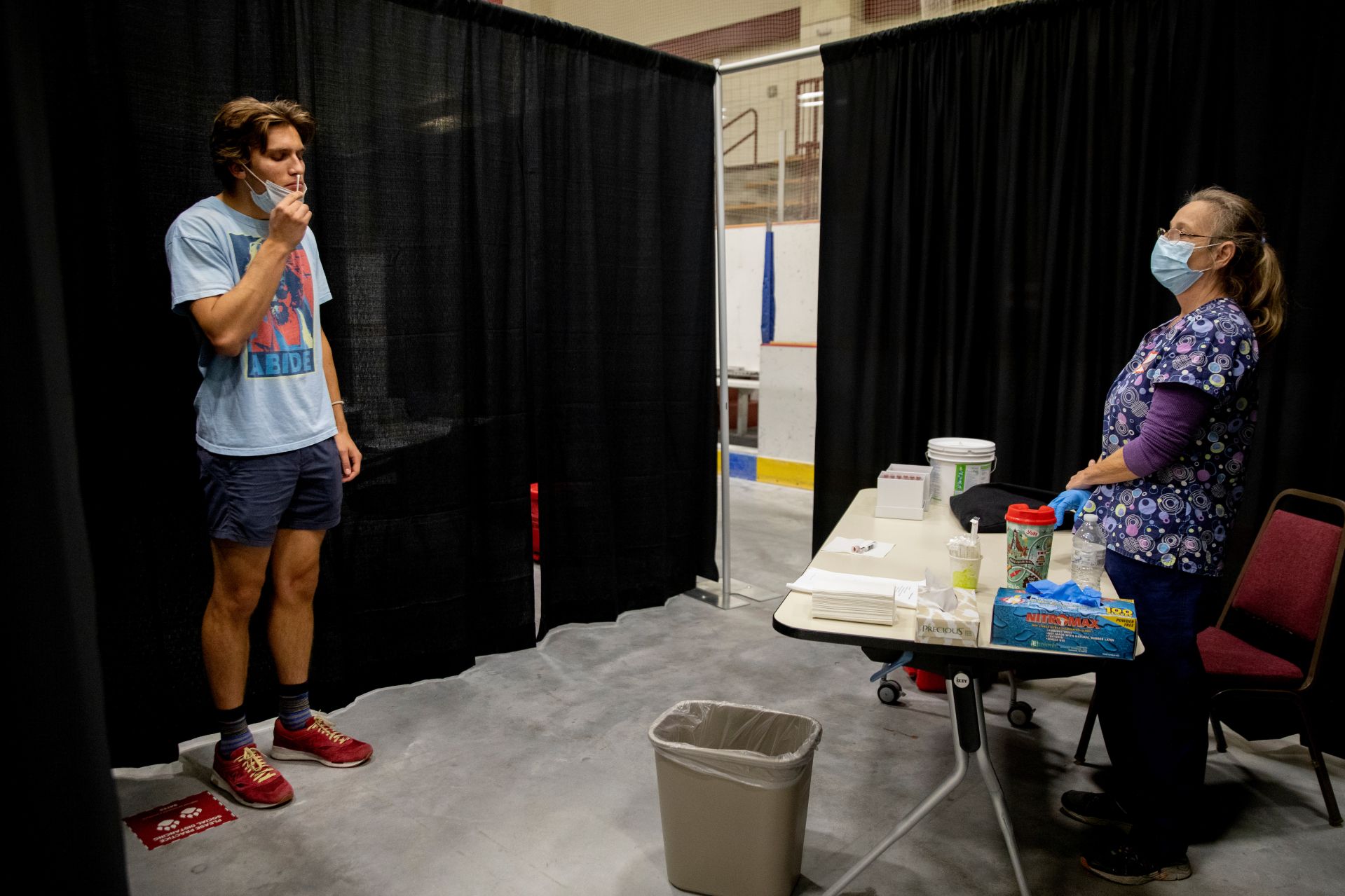
Throughout the fall, Bates required that each student be tested twice weekly. Employees had the option of being tested twice a week.
Like any medical procedure, swabbing one’s nose for a COVID-19 test is a personal experience. So I didn’t just walk in on Henry; he gave me permission, as did the medical assistant who observed the test.
I can’t tell you exactly what he was thinking during his test (I didn’t ask), but I know what it has felt like for me. With each of three deep swirls in each nostril, I felt that I was confronting my destiny and mortality.
It all sounds melodramatic, sure. But the relief I experience each week when I receive an email — within 24 hours — of my negative test results reminds me that, hyperbole or not, we are all living on the edge.
Celebrate
Theophil Syslo: Filmed for a video piece about the 2020 Sankofa presentation, this unpublished clip shows the curtain calls and spontaneous dance celebration following the student-produced event, held annually the evening of Martin Luther King Jr. Day.
I could easily have shared any clip from the performance — it was all so good — but I feel that this scene best captures the creative community that powers the annual show, and that great “we did it!” feeling at the end.
The students felt good, and so they danced.
Morning Routine
Phyllis Graber Jensen: When I wake up in the morning, one of the first things I do is glance out my east-facing bathroom window to see what’s up with the weather.
The best light of the day is at dawn and dusk. On this early mid-October morning, I saw a fog-filled vista and made the split-second decision to make a run to campus. Once you see what you want, if you don’t immediately jump, it’s gone.
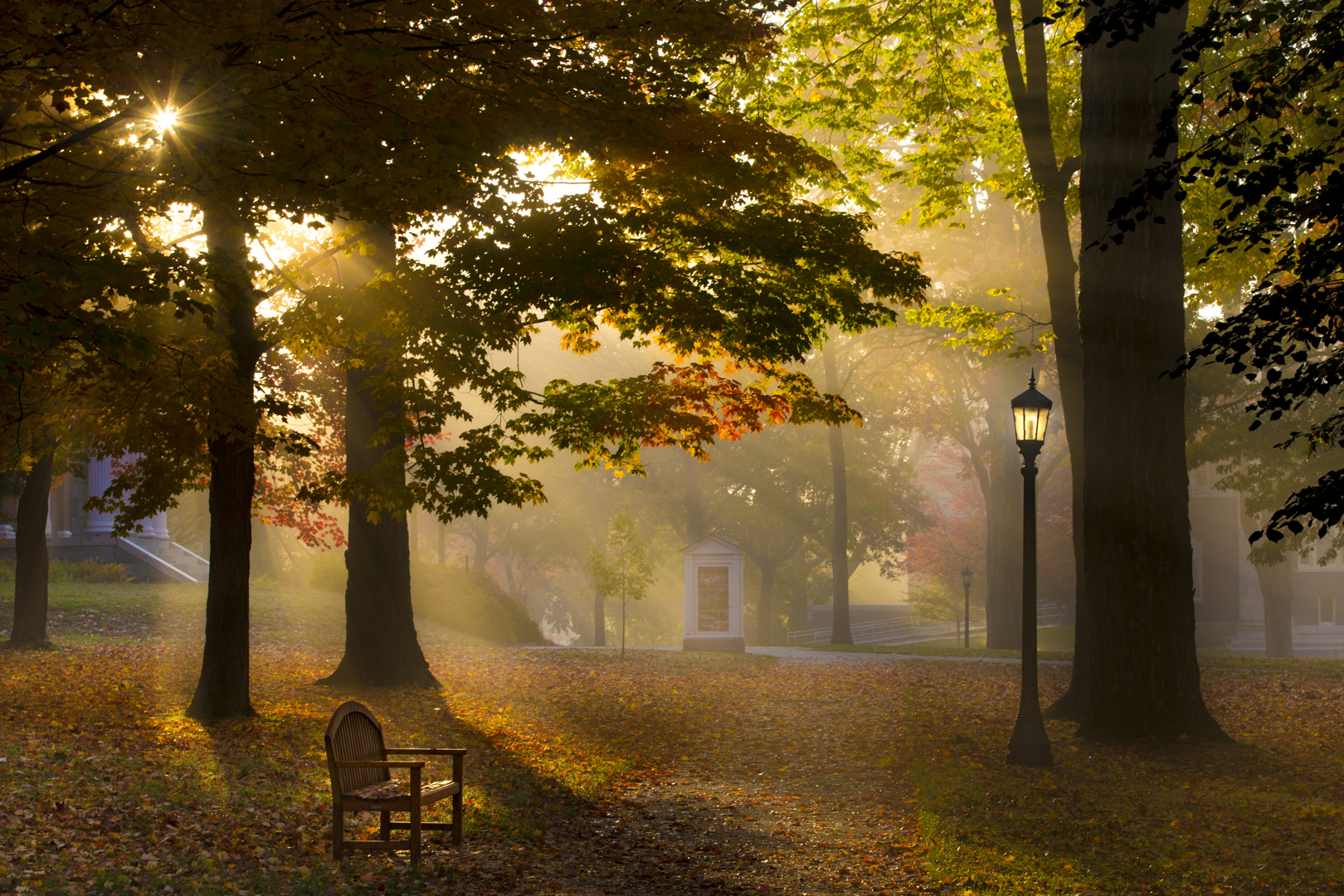
My own two feet are not as swift as my 13-year-old Toyota (let’s just call me lazy). I jumped into the car, shot up Campus Avenue, and hung a right onto College Street. Like an angler who knows the best fishing spots, I know where the best sunrise opportunities are at Bates.
Passing the Chapel and peering across the Historic Quad, I saw a lovely scene that exceeded my expectations. The magic was palpable. I had to get out of the car to make the photograph. But it was worth it.
Staying in Key
Theophil Syslo: Last February, my colleagues and I prowled around Olin Arts Center for three days, interviewing, filming, and photographing students and faculty members.
This clip shows Mathieu Moutou ’22 of Vacoas, Mauritius, in an Olin practice room, playing the piano. When you hear piano sounds like this, you know where you are on the Bates campus.
It’s a simple video sequence, but I like it. From what I understand, piano is not his main instrument — the violin is. So his fiddling on the piano, just blowing through those chords, is way beyond most of us. The clip feels so fun.
Remotely Possible
Phyllis Graber Jensen: Sheltering at home in March, I noticed that photographers were using Facetime to create remote portraits during the pandemic. For me, it meant possibility. I could continue to do what I enjoy so much: photographing students.
A Facetime portrait is just what it sounds like: You open a Facetime session with someone, and together you decide on a portrait location. Pressing the white display button creates a short video clip, from which you can select still images.
I approached a few seniors, offering them an opportunity to choose their environment and reflect on the meaning of these last weeks in their unanticipated displacement.

I photographed Andrew Garcia Bou ’20, in his Eastchester, N.Y., bedroom. Andrew had worked with me on digital-asset management for three years. He dedicated himself to the task and provided me with regular progress reports each time he departed our office. Other than his interdisciplinary major and standout performances as a varsity golfer, I knew little about him.
As he sat in his bedroom — and I in my kitchen — Andrew suddenly became three dimensional to me as he talked about his shortened senior year and his future plans, his disappointment and hope. I’d like to think that this picture communicates some of what he generously shared with me that day.
Uff da!
Theophil Syslo: During the pandemic, we’ve been very careful about engaging in projects involving close contact with students, faculty, and staff.
When we do, we follow the protocols that everyone is quite familiar with, including being outdoors. This clip, filmed for a profile of Vanessa Paolella ‘21, editor of The Bates Student, shows her delivering papers around campus. It also suggests how much “fat” there is on video clip: This sequence is five minutes long, and I used maybe 10 seconds of it in the final video.
Sometimes it feels like creating b-roll for a project mostly involves trotting along with a camera in front of my subject, as is happening here.
I should’ve said, “Yes” to Vanessa’s question, “Should I walk slower?” You can hear my “Uff da” — a common upper Midwestern term — after following Vanessa, herself a standout cross country runner, through her paces.
As you can sense from this clip, Vanessa has a strong sense of purpose, which she brought to her excellent work as editor.
Arise, Bobcat
Phyllis Graber Jensen: After the pandemic sent most students home from campus in March, we took a break on Instagram for several days. This was one of our first return attempts. “What to say and how to say it?” I wondered.
As with other notable Bates landmarks, I regularly pass and photograph the bronze Bobcat. So I didn’t have particularly high expectations for anything different at sunrise on my walk to Merrill Gym on March 30.
But I noticed the sunlight wrapping around the cat and decided to align the sun with the sculpture’s mouth. Make of it what you will. The caption read: “Looking for cat photos? Here is ours. The stalwart Bobcat at sunrise.”
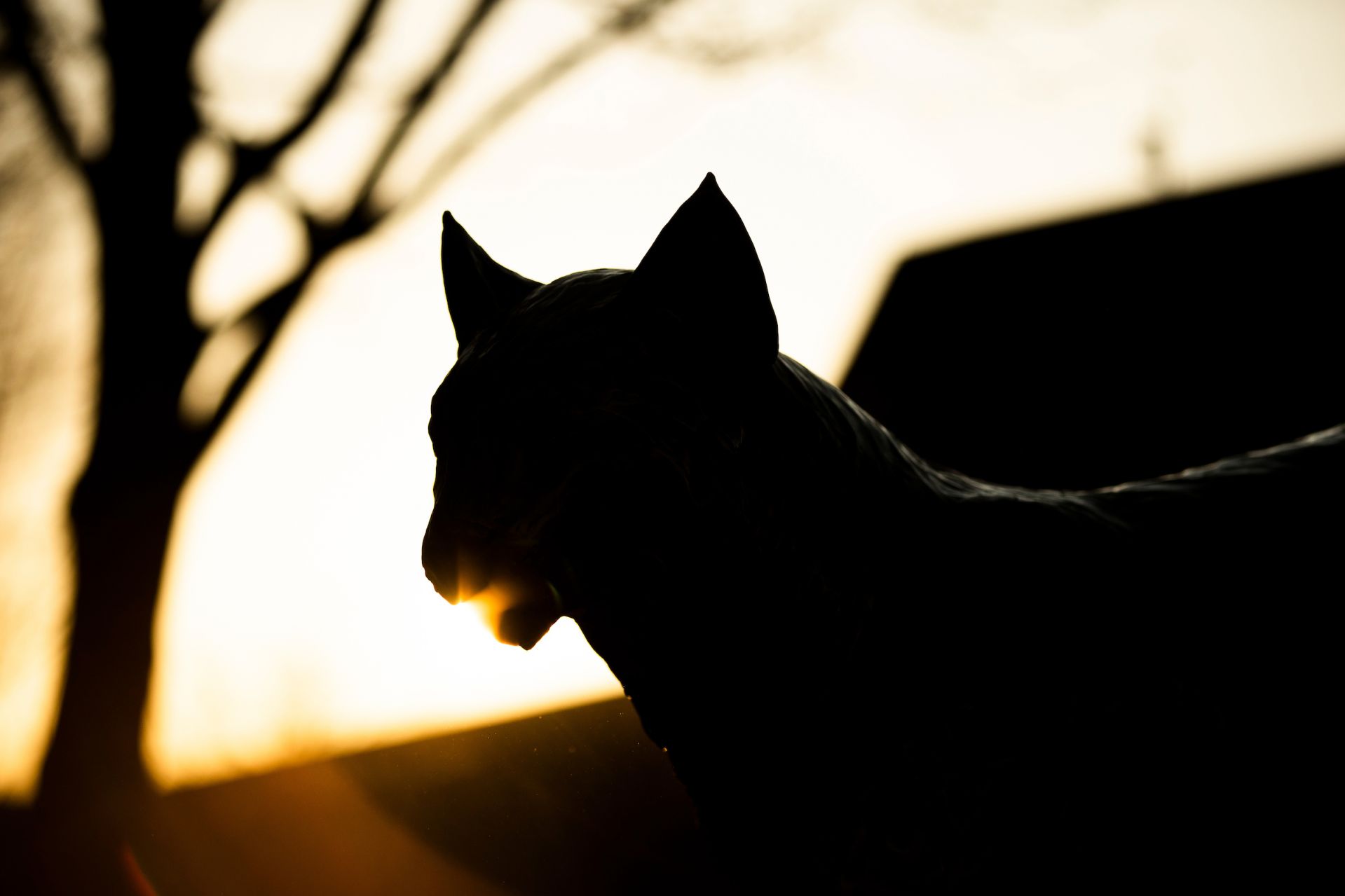
Light Touch
Phyllis Graber Jensen: In mid-winter, the afternoon sun floods the large south-facing windows of Olin Arts Center, creating dramatic shadows on the lobby’s white walls.
So I was elated when I entered Olin, walked down the hallway, and noticed, amidst these shadows, Associate Professor of American Studies Myron Beasley and Ollie Penner ’22 of Pasadena, Calif., a double major in art and visual culture and American studies.
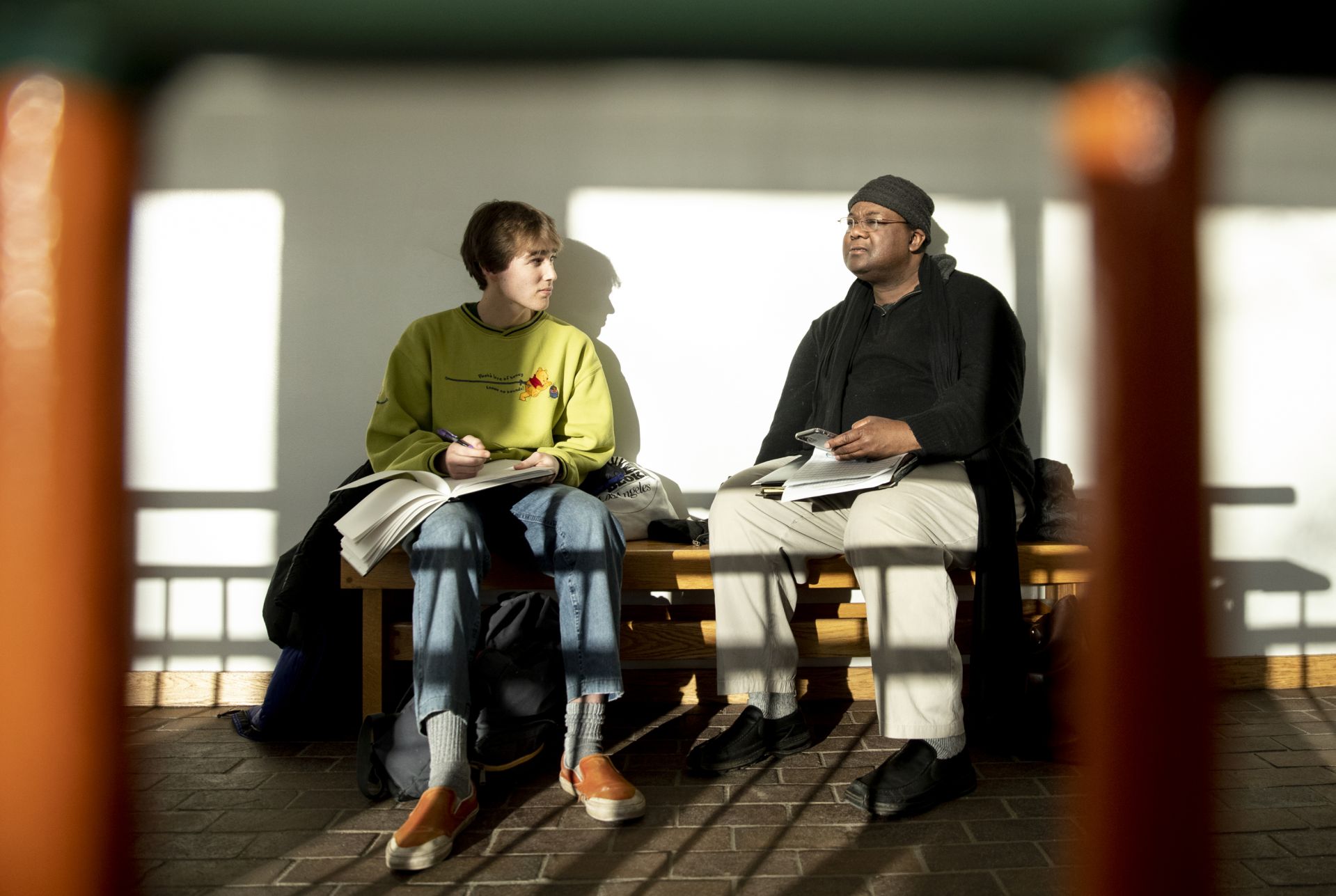
I quickly asked permission to photograph them, trying to minimize my disruption of their engagement. Then I decided to use a colorful staircase to frame the conversation.
Normally, I like to choose a frame where the student and professor gaze at one another. But in this case — the pair were discussing summer internships and art spaces — I appreciate Beasley’s moment of reflection, along with the use of his iPhone as a research tool. And I love how Penner, pen in hand, is intently focused on his teacher.
These faculty-student exchanges make up a vital part of the Bates experience; and you discover them only when you go out and search.
Life Line
Theophil Syslo: Bates had been doing remote learning for only a couple weeks when I joined two virtual Village Club Series events, each featuring Bates student performers.
It was early April, and students were really struggling, feeling so disconnected from each other. You could feel students just trying to reach out to each other, like grabbing for a life jacket when treading water in the deep end of the pool.
Performers came from everywhere, from New Zealand to a coastal Maine island. In this clip, Drew Collins ’20 flips pancakes with friends at their remote getaway while doing a followup interview with me.
While I hope that creating stories about Bates students from Zoom video doesn’t become the norm, it was rewarding to stitch together this film. You can see the ache of the students’ separation, and the joy of being “together.”
In the Mood
Phyllis Graber Jensen: “There’s still work to be done, and so the door to Hedge Hall opens once again.” That’s how I captioned this Instagram photograph.
Feeling low at the end of a February day, I gave myself five minutes to make an Instagram post — my version of the technical challenge on The Great British Baking Show.
Hedge’s incandescent glow attracted my attention, and the figure walking through the entryway provided the small thrill I needed to exit my mood. Cheers to light.
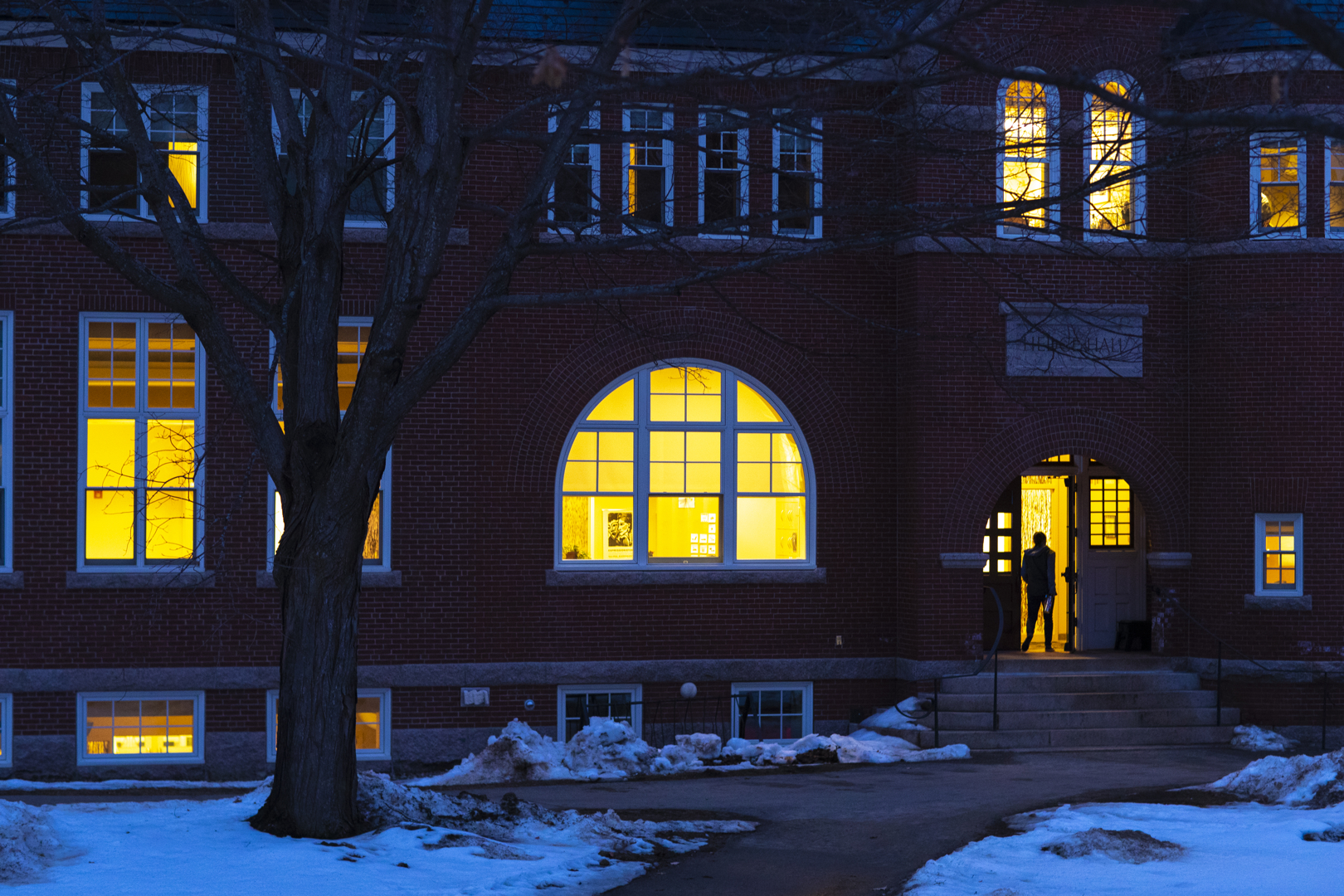
Count On It
Theophil Syslo: In this clip, captured for a student profile, Julia Gutterman ’20 leads members of the Robinson Players in “Count to 20,” a warm-up exercise that helps everyone get into the ensemble vibe. One person says “one” to start, then a different person says “two,” and so on. If two people say the same number at the same time the game starts over, which happens here.
While only a small part of the clip made it into my final project, I like it because it shows a transformation: The students are individuals, at first, having arrived at rehearsal from all over campus, having done all sorts of things.
But as they play the game, and get silly, they come together, like a team. You can feel it.
‘Our Last Time’
Phyllis Graber Jensen: Bates moved to remote learning in mid-March due to COVID-19. Anticipating the range of student goodbyes, I set out on March 16 to explore campus and found tender farewells at Lake Andrews, the bus stop outside Chase Hall, and here on Garcelon Field.
I entered Garcelon from Central Avenue and climbed the grandstand. From there, I photographed Alex Gailey ‘22 of Berkeley, Calif., and Christina Boudreau ’21 of Milton, Mass., saying their goodbyes.
I hesitated before walking onto the field. I had the picture, but not their particular narrative, the timeless “marriage of words and images” that would enrich their final representation. But was it worth wrecking whatever they had going on?
I descended the staircase. “He’s going to be abroad next year,” Christina told me. “This is our last time together on campus.”
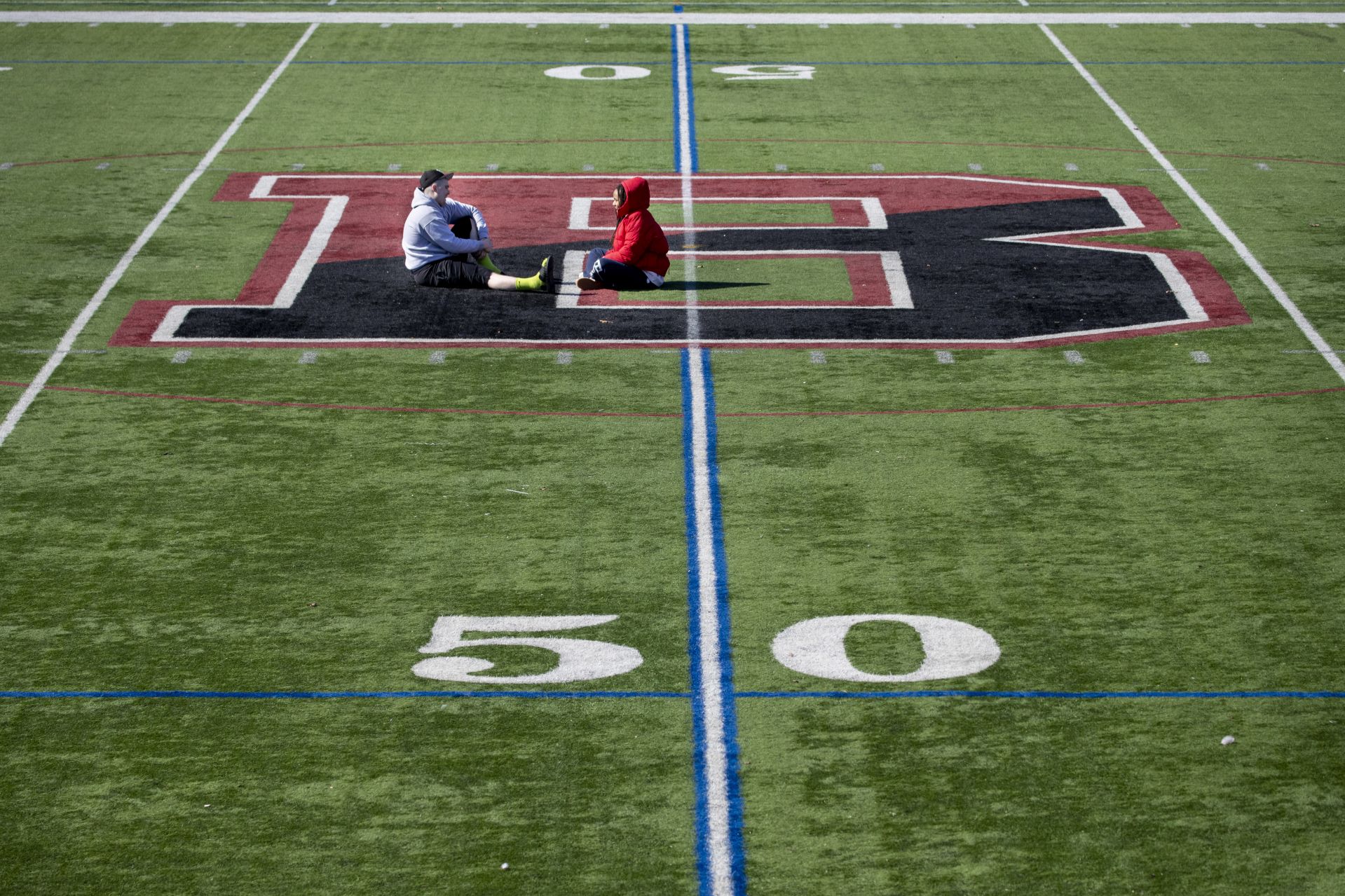
‘Walk with Me’
Theophil Syslo: In this clip, Ian Khara Ellasante speaks the last couple of lines of their poem, “grandfather: a dialect of water.” The poem is about a beloved grandfather, a man that Ellasante describes as “the epitome of integrity and tenderness, of grace, strength, and compassion.”
grandfather sit with me
tell me
i want to know what is over there to see
let me look at you he would say
river banks are not meant to hold
cry with me walk with me
You can hear Ian’s love for their grandfather in the words, and see the love in Ian’s face.
It was dramatically windy at the river that afternoon. I was nervous about capturing the audio. But Ian was right there with me, doing multiple readings in different places along the river of their beautiful poem. I am grateful to Ian for allowing me to feel a sense of collaboration on this project.
The poem earned Ian, an assistant professor of gender and sexuality studies, first prize in a poetry-writing contest sponsored by the literary magazine New Millennium Writings.
Final Introductions
Phyllis Graber Jensen: I have taken dozens of photos like this one, of an athlete sprinting through a team introduction line. The women’s lacrosse team does it well, with raised sticks and pre-game high spirits. It’s fun to photograph, but over time, the games tend to merge in the mind. Not this time, though.
Just before the 4:30 p.m. start of their March 10 game, the Bates coaches and players learned that it would likely be their final home game, due to the expanding pandemic.
Ultimately, it was the last spring game, period — and the last time team captain Caroline Kerrigan ’20 of Falls Church, Va., would take the field in a Bates uniform. For the record, Bates defeated the University of Southern Maine, 20-1.
The next day, the NESCAC canceled the spring sports season. Two days after that, Bates announced its decision to move to remote learning for the balance of the academic year.
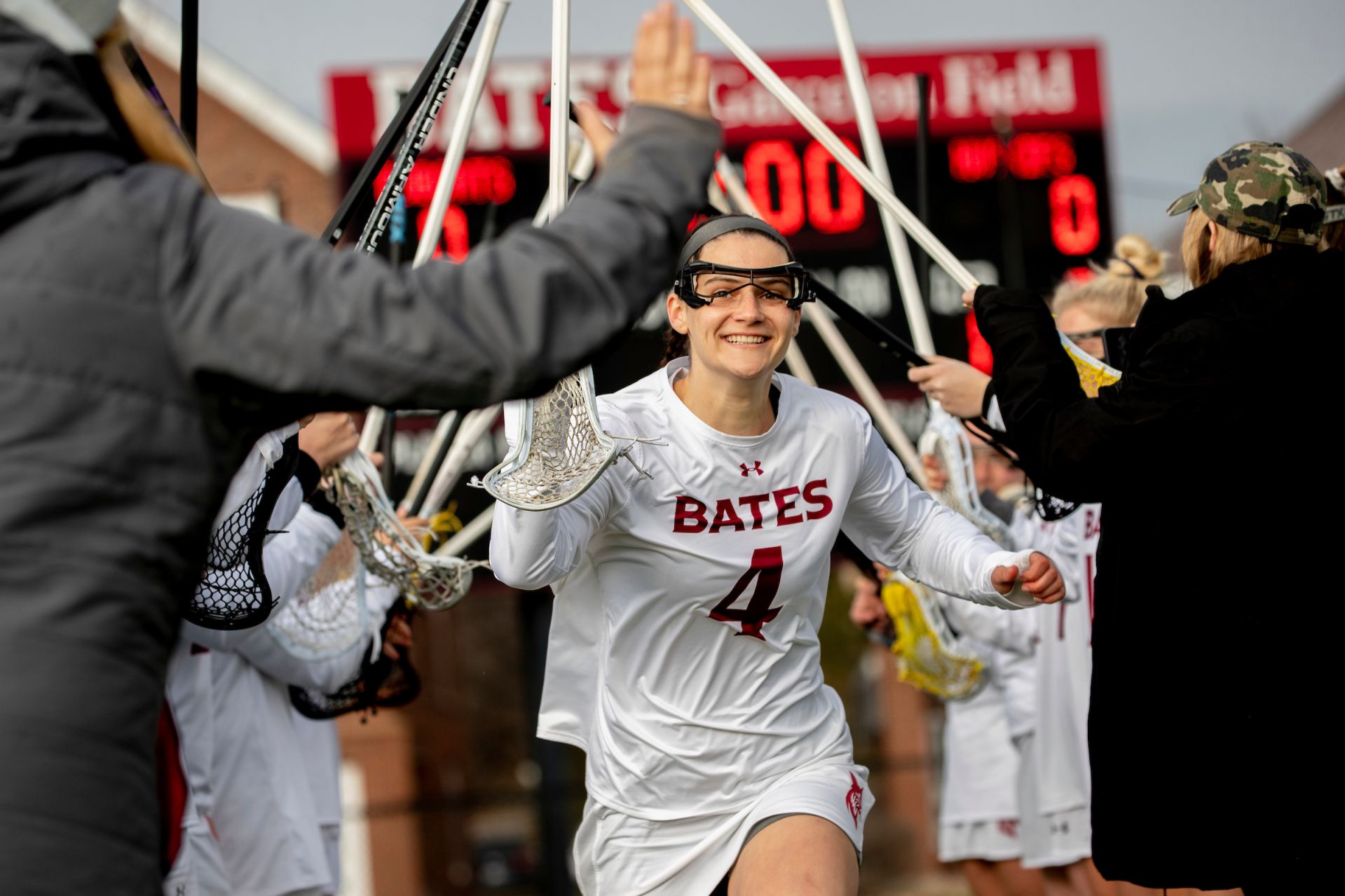
The Puddle’s Revenge
Theophil Syslo: Covering the annual Puddle Jump is a blast. But I’ve had my share of challenges. In 2019, I lost a GoPro while capturing underwater video.
In 2020, I decided to stay away from the water and try to create some eye-popping portraits along the shoreline, using a background stand and seamless paper. I thought I’d be safe from accidents, but then the backdrop ripped and gave way — it was no match for rambunctious puddle-jumpers. Next time I’ll go all MacGyver with more gaffer tape. Third time’s a charm?
With an annual event like the Puddle Jump, we try to stretch our creative muscles — which sometimes means pulling a muscle! Our goal: to present to our audiences something that’s as creative as our students.
Edging Closer
Phyllis Graber Jensen: Appearances deceive. This photograph of two masked people kneeling before a pile of dirt in a field, one with a knife, might suggest something nefarious. Nope. It’s just another day of environmental studies fieldwork.
Doing such fieldwork at Pettengill Farm, a historic saltwater farm perched on an estuary of the Harraseeket River, environmental studies professor Holly Ewing had stopped to discuss soil samples with Sophia Miller ’21 of New York City. The course was “Soils,” which digs into the science of dirt.
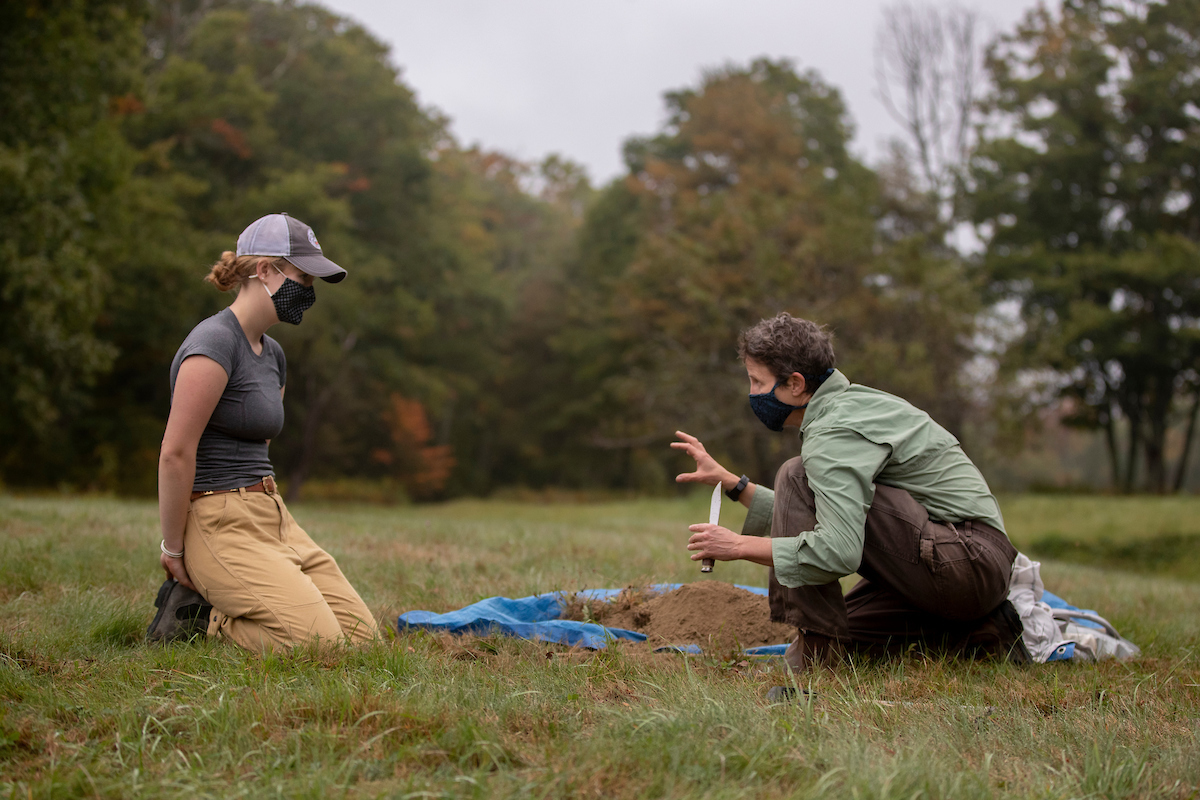
Ewing, the Christian A. Johnson Professor of Interdisciplinary Studies, uses the knife to scrape the side of the soil pit to expose a clean surface for examination. It’s “dull as a butter knife,” she said.
Dull or not, the knife added a kick to distinguish the photograph from business as usual. And it’s a nice visual companion to what made the trip memorable for me: 40 mosquito bites. Yes, I counted.
‘May It Be So’
Theophil Syslo: An in-person Commencement was a casualty of the pandemic. The Class of 2020’s graduation was a virtual production, featuring video segments recorded in the weeks prior to the May 31 event.
This clip, captured on May 11, shows a physically distanced recessional from the Coram Library porch with President Clayton Spencer, Dean of the Faculty Malcolm Hill, and Multifaith Chaplain Brittany Longsdorf.
The plan was to pair the scene of the recessional with the sounds of the Hathorn Bells, similar to the in-person version. (In the clip, you can hear me say, “You’ll hear bells toll,” to which Spencer says, “For whom?”)
Using a phrase from the old world of acetate film, the clip ended up on the cutting-room floor. Instead, we ended the video with the closing words of Longsdorf’s benediction, in which she had described the beauty and richness of “sacred Bates days and nights,” followed by a montage of photographs set to the steel-pan music of a typical Commencement.
It was my job to produce the video. In the weeks after the college went to remote learning, I had created several projects featuring seniors, using Zoom and other remote-capture technology.
In any typical year, so many players work together to create a successful Bates Commencement; in this most atypical year, we had to envision a new way of presenting Commencement. Creating a virtual Commencement with other Bates staff was our way of trying to help our seniors and their families find happiness and completion in such a difficult moment.
Arm in Arm
Phyllis Graber Jensen: I admire Perla Figuereo ’21 and Lebanos Mengistu ’21.
From their initial days on campus, when I photographed them bowling with new classmates in Bobcat First, they’ve developed into thoughtful, forceful, and compassionate campus leaders.
Perla is a double major in theater and in rhetoric, film, and screen studies from the Bronx, N.Y. Lebanos is a double major in politics and Africana from Somerville, Mass. Together, they’re co-presidents of Bates Student Government.
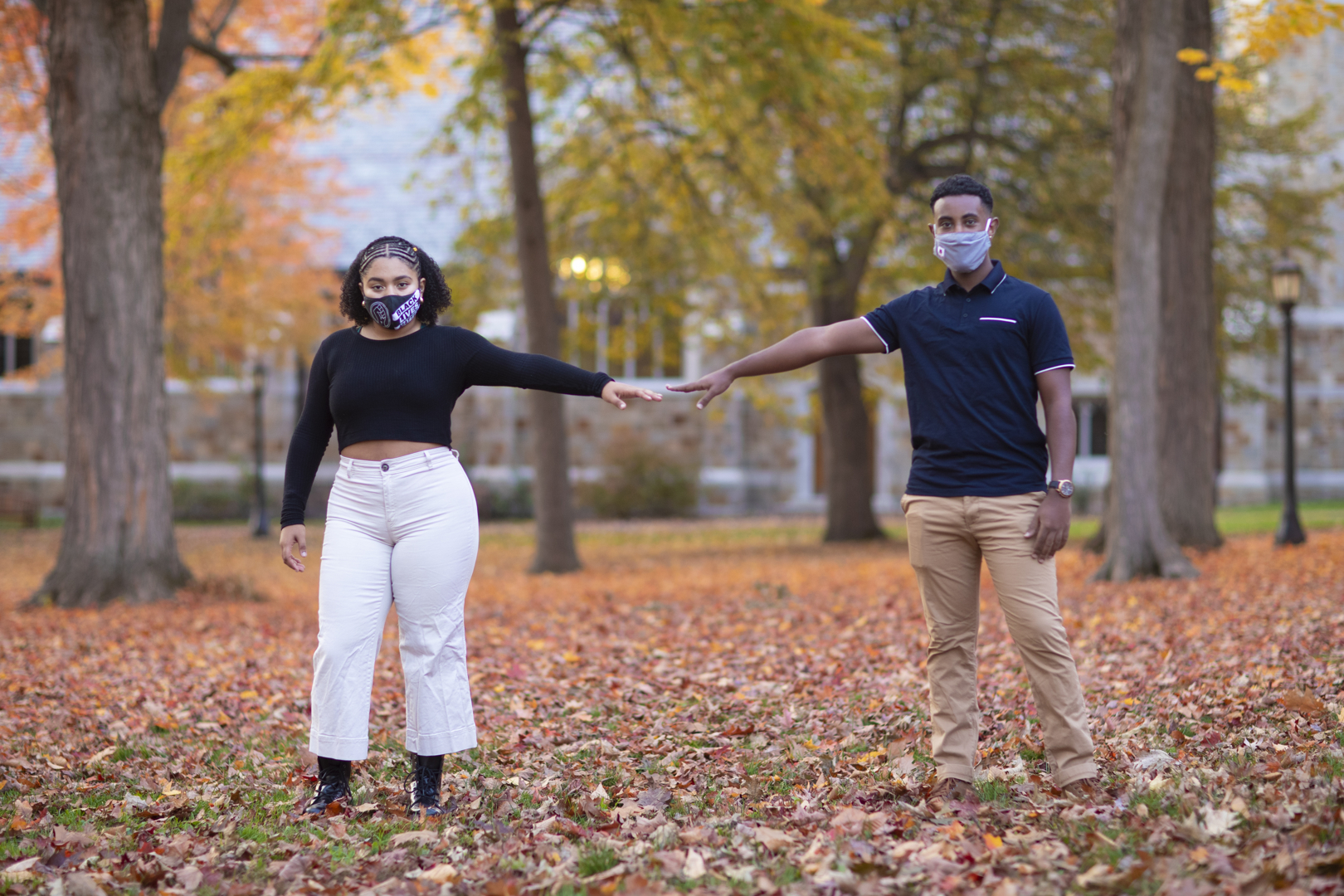
Asking them to physically distance for this portrait, I was surprised when they extended their arms to create the required 6 feet — I hadn’t seen that trick before. Though the gesture was pandemic-related (and helpful to the photographer), those outstretched arms personify strength in connection and community.
‘I Know How to Spell!’
Theophil Syslo: Though this clip never made it into my profile of Sam Findlen-Golden ’20, it captures a funny moment involving another student that I had profiled, Maddie Hallowell ’20.
Here, the Robinson Players are rehearsing a scene for their production of The 25th Annual Putnam County Spelling Bee. The play involves improv, with audience members taking part.
Maddie is helping out, playing an audience member. So the cast can rehearse the song that’s sung to departing bee contestants, she has just intentionally flubbed the word “extinguish.”
I knew that Maddie would return to her seat after the scene, so I planted myself nearby. As the clip ends, Maddie says to friends, “I know how to spell ‘extinguish’!” It’s a charming moment that reflects what I know about Maddie: She’s present and reactive in the moment. And funny.
Momentous Occasion
Phyllis Graber Jensen: The busy first floor of Ladd Library is rarely quiet. And in March and April, it can be raucous at times as seniors bind theses with friends, a Bates tradition that grows stronger by the year (even as digital submissions become the norm).
English major Jonathan Farrell ’20 of Middletown, Conn., did a yearlong creative writing thesis, advised by Lecturer in English Jessica Anthony ’96, writing a series of short stories in which the characters cope, in different ways, with loneliness.
Like so many seniors, Jonathan felt a desperate need for closure as the college transitioned to remote learning in March. Though his thesis wasn’t quite done, he and a group of friends gathered in the library on Saturday morning, March 14, to bind it, shortly before he left campus.
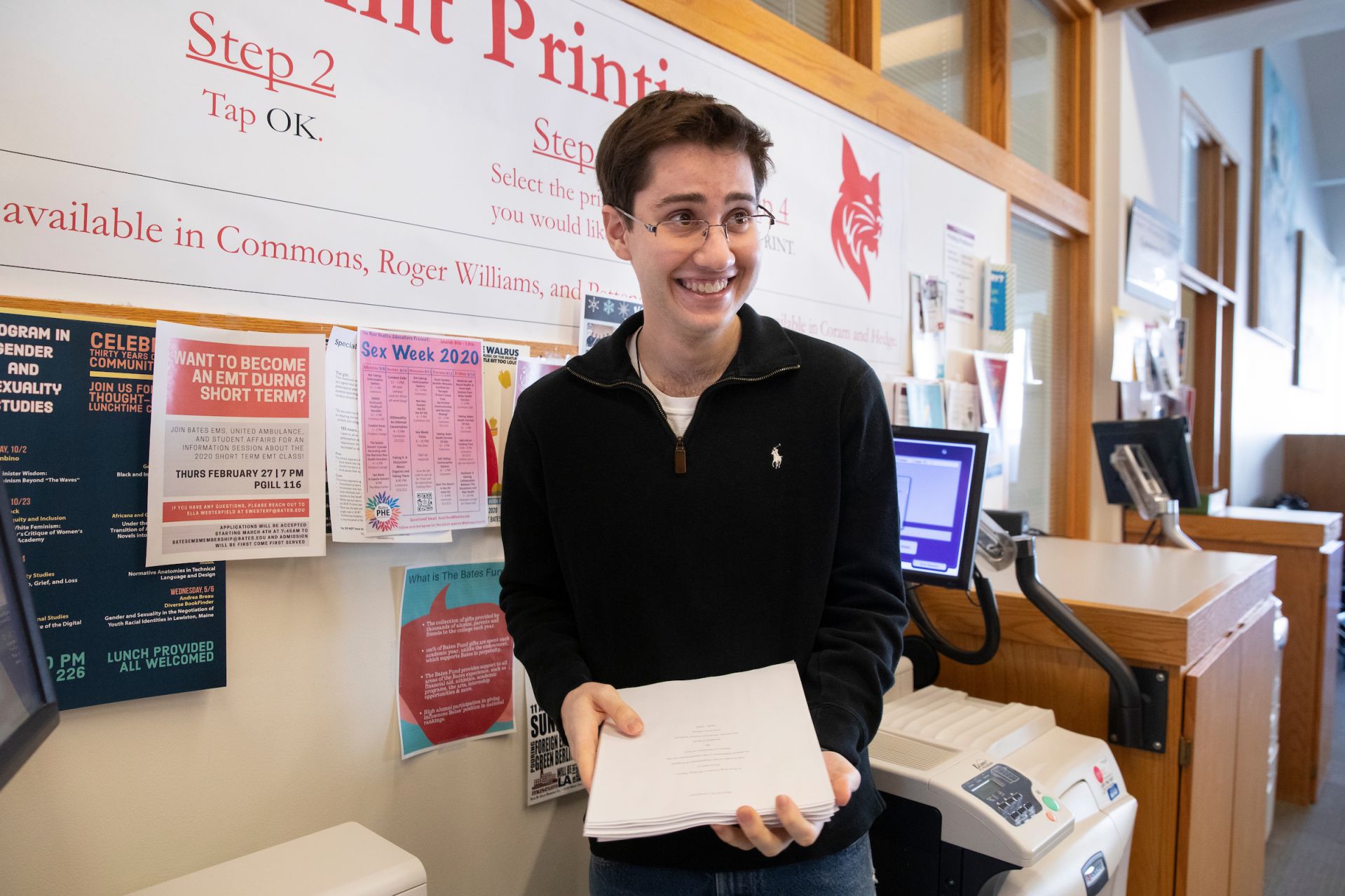
I have other photographs of this event, ones showing Jonathan surrounded by his buddies — his rock-climbing friend, Steve Shea ’22 of Wilson, Wyo., helped him do the traditional binding —and popping a champagne cork on the Library Terrace.
But this quiet moment, as he looks toward his out-of-the-frame friends, amazed that he has concluded this long, gratifying journey, and grinning widely in anticipation of the crowning moment, says just as much.
